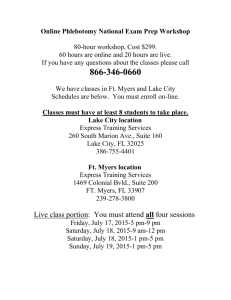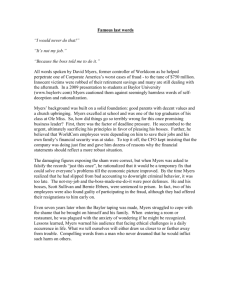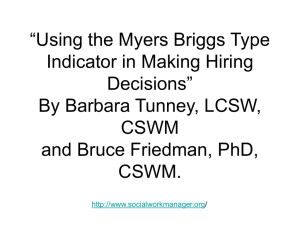Facilitated by: Lynn Davis
advertisement
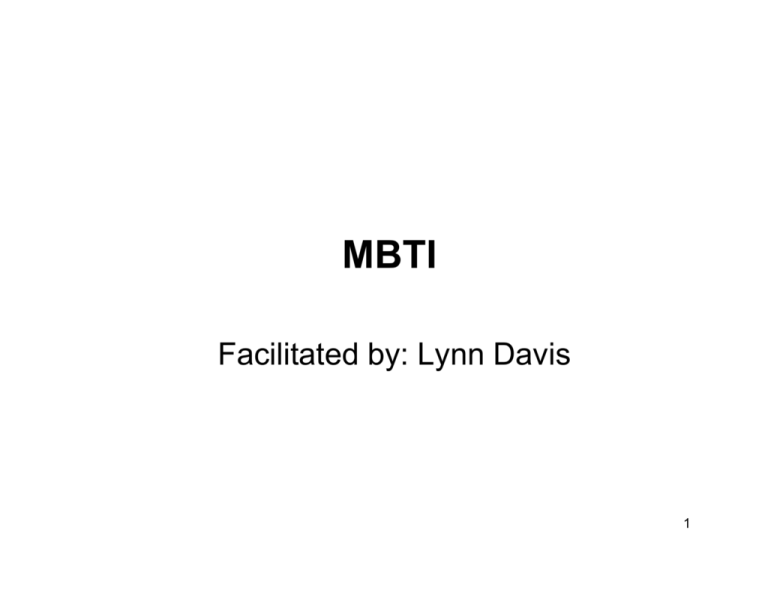
MBTI Facilitated by: Lynn Davis 1 Objectives • An overview of the Myers Briggs Type Indicator. • How you can use the Myers Briggs concepts in the interview process and in the workplace. 2 3 Overview of the Myers Briggs Type Indicator (MBTI) and how it is traditionally used • The Myers Briggs Type Indicator comes from Jungian psychology and was developed by a mother and daughter team during World War II in England. 4 Myers Briggs Type Indicator (MBTI) • Indicates inborn preferences, in the same way as right-handedness or lefthandedness. • Is not predictive of behavior, as the person has a choice of how to use preferences. • Does not have a “lie scale”, so a person can slant his or her answers to present a different profile. 5 Behavioral Classification Reviewing the Theories: gJUNGIAN Theory of 4 basic personality types (1930s); gKathryn Briggs developed idea further: 0Worked with Daughter to develop Myer-Briggs Type Indicator (MBTI) 0Patent applied for in 1942 6 Behavioral Classification ISTJ ISFJ INFJ INTJ ISTP ISFP INFP INTP ESTP ESFP ENFP ENTP ESTJ ESFJ ENFJ ENTJ 7 Preference Definitions 8 According to Jung’s typology, all people can be classified using three criteria, these criteria are: • • • • Extroversion - Introversion Sensing - Intuition Thinking – Feeling Isabel Briggs Myers added the fourth criterion: • Judging – Perceiving 9 • The first criterion defines the source and direction of energy expression for a person. • The extrovert (E) has a source and direction of energy expression mainly in the external world while the introvert (I) has a source of energy mainly in the internal world. 10 GROUP EXERCISE E/I DICHOTOMY • At your table or group separate into two group— Extraverts and Introverts • Brainstorm for 5 minutes and record responses around the question, “What work environment allows you to be most effective?” • Discuss the responses with each other for 10 minutes. 11 • The second criterion defines the method of information perception by a person. • “Sensing” (S) means that a person believes mainly information he or she receives directly from the external world. “Intuition” (N) means that a person believes mainly information he or she receives from the internal or imaginative world. 12 GROUP EXERCISE S/N DICHOTOMY • Imagine a “Red Apple!” • Write about it for 5 minutes • Two or three volunteers from each type to read what they wrote • Review the differences 13 • The third criterion defines how the person processes information. • “Thinking” (T) means that a person makes a decision mainly through logic. “Feeling” (F) means that, as a rule, he or she makes a decision based on emotion. 14 • The fourth criterion defines how a person implements the information he or she has processed. • “Judging” (J) means that a person organizes all his or her life events and acts strictly according to this plan. “Perceiving” (P) means that he or she is inclined to improvise and seek alternatives. 15 • The different combinations of the criteria determine a type. There may be sixteen types. Every type has a name (or formula) according to the combination of criteria. For example: • ISTJ • Introvert Sensing Thinking Judging • ENFP • Extrovert Intuitive Feeling Perceiving • There are refinements within the types, as well, which determine whether the 2nd or 3rd criterion is dominant for that individual. For our purposes we will not go into that much detail. 16 Behavioral Classification ISTJ ISFJ INFJ INTJ ISTP ISFP INFP INTP ESTP ESFP ENFP ENTP ESTJ ESFJ ENFJ ENTJ 17 Behavioral Classification ISTJ ISFJ Doing what should be done ISTP ISFP Will to try anything once ESTP ESFP The ultimate realists ESTJ ESFJ Life’s administrators INFJ INTJ High sense of duty INFP INTP Sees much but shares little ENFP ENTP You only go round once ENFJ Hosts & Hostesses ENTJ 18 Behavioral Classification ISTJ ISFJ INFJ Everything can be improved Inspiration to others ISTP ISFP INFP Performing noble service ESTP ESFP ESFJ ENTP One exciting challenge after another ENFJ Smooth talking persuaders INTP Loves problem solving ENFP Giving Life an extra squeeze ESTJ INTJ ENTJ Life’s natural Leaders 19 Work 20 21 22 23 Behavioral Cues During Communication Talk it out Extraverts Rapid speech, interrupt, louder volume to voice, appear to thing aloud Think it Through Introverts Pause in answering or giving information, quieter voice volume, shorter sentences, not run on Specifics Sensing Types Ask for step-by-step information or instruction, ask “what” and “how” question, use precise descriptions The Big Picture Intuitive Types Ask for the purpose of an action look for possibilities, ask “why” questions, talk in general terms Logical Implications Thinking Types Appear to be testing you or your knowledge, weigh the objective evidence, are unimpressed that others have decided in favor, conversations follow a pattern of checking logic: “if this, then that” Impact on People Feeling Types Strive for harmony in the interaction, may talk about what they value, ask how others have acted or resolved the situation, matters to them whether others have been taken into account Joy of Closure Judging Types Impatient with overly long descriptions, procedures, the tone is “hurry up—I want to make this decision,” may decide prematurely, enjoy closure Joy of Processing Perceiving Types Seem to want “space” to make own decisions, the tone is “let’s explore,” what are some more factors to consider, may decide at the last moment, enjoy processing 24 Typical Work Stressors for Each of the Eight MBTI Preferences Stressors for Extraverts communicating by email, lengthy work periods with no interruptions, having to reflect before taking action, having to focus in depth on one thing, getting feedback in writing only Stressors for Introverts Working with others, talking on the phone a lot, interacting with others frequently, having to act quickly without reflection, too many concurrent tasks and demands, getting frequent verbal feedback Stressors for Sensing Types Attending to own and others’ insights, having to do old things in new ways, having to give an overview without details, looking for the meaning in the facts, focusing on possibilities, too many complexities Stressors for Intuitive Types Having to attend to realities, having to do things the proven way, having to attend to details, checking the accuracy of facts, needing to focus on past experience, being required to be practical Stressors for Thinking Types Using personal experience to assess situations, noticing and appreciating what is positive, focusing on processes and people, using empathy and personal values to make decisions Stressors for Feeling Types Analyzing situations objectively, setting criteria and standards, critiquing and focusing on flaws, focusing on tasks only, being expected to use logic alone to make decisions, asking questions that feel divisive Stressors for Judging Types Waiting for structure to emerge from process, being expected to use “inner timing,” too much flexibility around time frames and deadlines, staying open to reevaluations of tasks, dealing with surprises Stressors for Perceiving Types Having to organize selves' and others’ planning, working within time frames and deadlines, others’ distrust of last-minute energy, having to finish and move on, developing contingency plans, being required 25 to plan ahead Examples of contradictory preferences • An introvert is asked to do marketing and public relations as well as writing for publication. • An ENFP is expected to maintain an accurate and detailed database of client resources as well as organizing community groups. 26 27 28 29 30 One More Thought 31 32 Questions??? 33 BIBLIOGRAPHY FOR MYERS BRIGGS PRESENTATION October 26, 2006 NASW Texas • • • • • • • • • • • • • Websites: All of the websites have links to many other sites. This is a sample of a list generated from entering Myers Briggs in the Google search box. www.myersbriggs.org Their mission is to continue the work of Katharine Cook Briggs and Isabel Briggs Myers in the field of psychological type, especially the ethical and accurate use of the Myers Briggs Type Indicator. www.teamtechnology.co.uk This site contains a PowerPoint presentation explaining the basic concepts of the Myers Briggs. There are many links to sites for the test and articles regarding many aspects of uses for the test results. www.personalitypathways.com The site contains an informal short test that helps people verify their Myers Briggs personality type. www.wikipedia.org A description of the history, type dynamics and further reading resources, such as articles and news stories. Books: Berens, Linda V., etal, Quick Guide to the 16 Personality Types in Organizations: Understanding Personality Differences in the Workplace. Huntington Beach, CA.: Telos Publications, 2001. Keirsey, David. Please Understand Me II. 3rd ed. Del Mar, CA.: Prometheus Nemesis Books, 1998. Martin, Charles R., Looking at Type and Careers. Gainesville, FL.: Center for Applications of Psychological Type, 1995. 34 Tropman, John E. Supervision and Management in Nonprofits and Human Services. Peosta, IA.: Eddie Bowers Publishing Co, Inc., 2006.
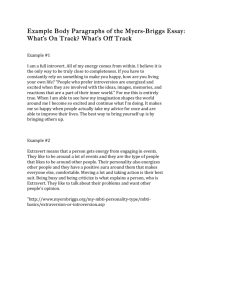
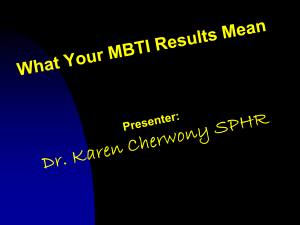
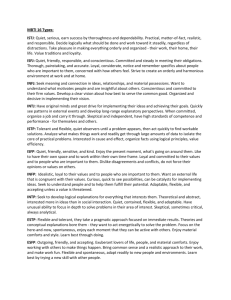
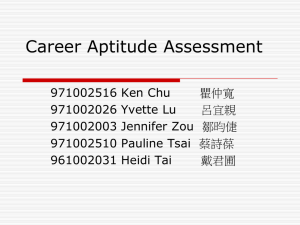
![Transformational Change [Powerpoint Presentation]](http://s2.studylib.net/store/data/005447411_1-da0a83bd34bdb90183940ab700125003-300x300.png)
